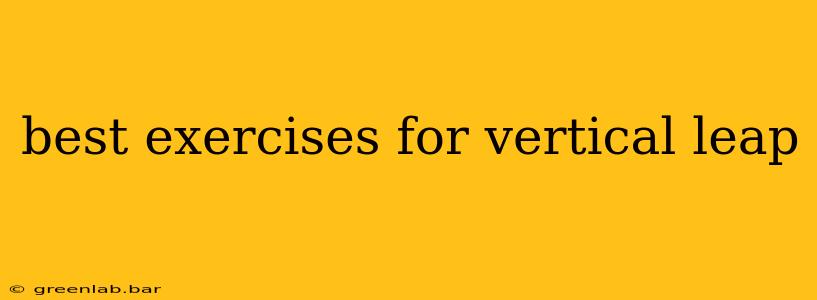Want to elevate your game and jump higher? Increasing your vertical leap isn't just about genetics; it's about dedicated training and the right exercises. This comprehensive guide dives deep into the best exercises to improve your vertical jump, covering everything from plyometrics to strength training. Whether you're a basketball player aiming for that game-winning dunk or a volleyball player striving for a powerful spike, this plan will help you reach new heights.
Understanding Vertical Jump Mechanics
Before we dive into specific exercises, it's crucial to understand what contributes to a powerful vertical leap. Your vertical jump is a complex movement requiring a combination of:
- Strength: Powerful leg muscles (quadriceps, hamstrings, glutes) are essential for generating explosive force.
- Power: The ability to quickly transfer strength into movement is key. This involves both strength and speed.
- Flexibility: Tight muscles can restrict your range of motion, limiting your jump height.
- Neuromuscular Coordination: Efficient communication between your brain and muscles is crucial for optimal performance.
The Best Exercises for a Higher Vertical Leap
This program focuses on building the necessary strength, power, and flexibility for maximizing your vertical jump. Remember to warm up thoroughly before each workout and cool down afterward.
Plyometrics: Explosiveness is Key
Plyometrics are exercises that use explosive movements to build power. They are crucial for improving your vertical leap.
- Box Jumps: A fundamental plyometric exercise. Start with a low box and gradually increase the height as you get stronger. Focus on landing softly to minimize impact.
- Depth Jumps: Stand on an elevated surface (around 12-18 inches), step off, and immediately jump as high as possible. This enhances your reactive strength.
- Jump Squats: Perform a squat, then explode upwards into a powerful jump. This combines strength and power.
- Lateral Bounds: Jump laterally, focusing on explosive power in each jump. This improves leg power and overall coordination.
Strength Training: Building the Foundation
Strength training is vital for building the foundation of muscle mass needed for explosive movements.
- Squats: The king of leg exercises. Variations like barbell back squats, front squats, and goblet squats target different muscle groups.
- Deadlifts: Develops overall lower body strength and power, crucial for transferring force to the ground. Focus on proper form to prevent injury.
- Leg Press: A good alternative to squats, particularly if you have back problems. Allows for heavy weight lifting to build muscle mass.
- Lunges: Improve balance and strengthen individual leg muscles. Variations include forward, reverse, and lateral lunges.
- Calf Raises: Strengthen calf muscles, important for pushing off the ground effectively.
Flexibility and Mobility: Unleash Your Potential
Flexibility and mobility are often overlooked but are crucial for maximizing your jump height.
- Dynamic Stretching: Arm circles, leg swings, and torso twists improve blood flow and prepare muscles for exercise. Perform these before your workout.
- Static Stretching: Hold stretches like hamstring stretches, quad stretches, and calf stretches for 30 seconds after your workout. This improves flexibility and reduces muscle soreness.
Workout Structure
A sample workout routine could look like this (adjust based on your fitness level):
Day 1: Plyometrics (Box Jumps, Depth Jumps) Day 2: Strength Training (Squats, Deadlifts) Day 3: Rest or Active Recovery (light cardio) Day 4: Plyometrics (Jump Squats, Lateral Bounds) Day 5: Strength Training (Leg Press, Lunges, Calf Raises) Day 6 & 7: Rest or Active Recovery
Important Considerations
- Progressive Overload: Gradually increase the intensity and volume of your workouts to continue challenging your muscles and improving your vertical jump.
- Proper Form: Focus on maintaining correct form throughout all exercises to prevent injuries. Consider working with a trainer initially to learn proper technique.
- Nutrition: Fuel your body with a balanced diet rich in protein and carbohydrates to support muscle growth and recovery.
- Rest and Recovery: Allow your body sufficient time to recover between workouts to avoid overtraining.
By following this comprehensive guide and consistently dedicating yourself to training, you'll significantly improve your vertical leap. Remember that consistency, proper technique, and a well-rounded approach are key to achieving your goals. Keep pushing yourself, and you'll soon be soaring to new heights!

